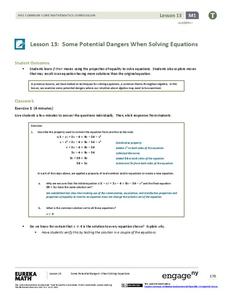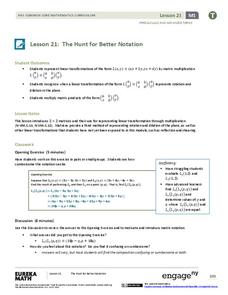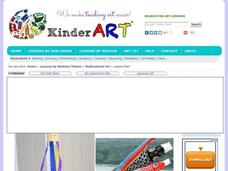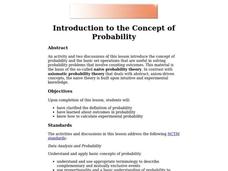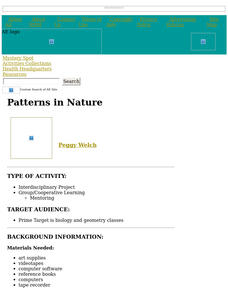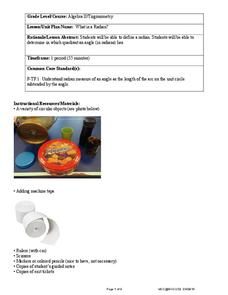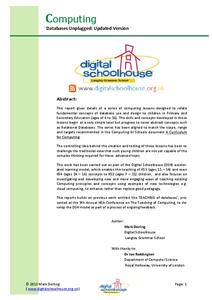EngageNY
Some Potential Dangers When Solving Equations
Need a less abstract approach to introducing extraneous solutions? This is it! Young mathematicians explore properties used to solve equations and determine which operations maintain the same solutions. They...
EngageNY
The Hunt for Better Notation
The matrix — it's not just a movie. The lesson introduces the concept of 2 x 2 matrix multiplication as a way to represent linear transformations. Class members determine when a linear transformation represented as matrix...
Curated OER
Art: 1950s Art
Students explore art of the 1950s. In this art history lesson, students examine works by Kofman, Groky, deKooning, Indiana, Hamilson, and Warhol as they identify the attributes of Abstract Impressionism and pop art. Students...
Curated OER
Dreaming with Marc Chagall
Students scrutinize the early twentieth-century artists who dealt with expressionism and abstraction, especially Marc Chagall. This four lesson unit examines the life and work of Chagall and supports the student creation of works similar...
Curated OER
Lost in Translation
Students reflect on the uses of mathematics in their daily lives and work in pairs to design brochures that make specific mathematical concepts clear and interesting to a popular audience.
Curated OER
Japanese Abstract Wind Sock
Students create Abstract Wind Socks using brown paper bags, markers, kite string, and basic art supplies in this Art lesson for the elementary classroom. Abstract concepts are emphasized and it is recommended to only use primary colors.
American Chemical Society
The Periodic Table and Energy-Level Models
Teach your class to think of electrons as tiny packets of energy that travel in waves. Through a short video and diagram, participants see how electrons are located around the nucleus of an atom. They then get into groups and try to...
Curated OER
Abstraction-Critique of Art
Middle schoolers apply a four step critique process as they observe and make personal decisions about abstract artworks.
Curated OER
Dinosaurs and George Washington: The Concept of old and new
Students read stories about the past and present and discuss the concept of old and new. In this old and new lesson plan, students discuss what makes something old and what makes it new by using stories as a reference.
Curated OER
Test Your Vocabulary Skills - Abstract Nouns
In this vocabulary worksheet, students learn that an abstract noun is a noun that does not have a physical form. Students write abstract nouns to match twenty adjectives.
Curated OER
Test Your Vocabulary Skills- Abstract Nouns 2
In this vocabulary worksheet, students recall that an abstract noun is a noun that does not have a physical form. Students write a matching abstract noun for a list of twenty adjectives.
Curated OER
Getting Students to Understand Why Learning Mathematical Concepts is Important
You can give a fresh response to that perennial question "when will we ever use this, anyway."
Curated OER
Poetry, Take Me Away!
Students explore a variety of poetry and poetry concepts. They examine figurative language, mood, and literary devices. The students write and recite their own poetry.
Curated OER
The Measurement Man
Students explore the measurements of capacity by constructing a creative project in the shape of a man. The man has body parts that represent different units of measurement and can be used to make conversions. This is highly concrete and...
Curated OER
Introduction to the Concept of Probability
Middle and high schoolers have a clarified definition of probability, they explore about outcomes in probability and how to calculate experimental probability. They use computers to learn about probability.
Illustrative Mathematics
Slopes and Circles
An upper-level treatment of what is often presented as a basic concept (the right angle of an inscribed circle on the diameter), this activity really elevates the mathematical thought of the learner! Expected to develop formulas...
Curated OER
Instruction on Nouns
More of a short lesson than a worksheet, this exercise gives instruction on the definition of nouns. Young writers discover common, proper, singular, plural, concrete, and abstract nouns. Excellent!
Curated OER
Patterns in Nature
Research patterns in nature which illustrate biological and mathematical concepts. Your class will discover and explore aspects of fractals, Fibonaccis numbers, whale and butterfly migration patterns, whale identification, flower...
West Contra Costa Unified School District
What Is a Radian?
Here's an algebra II activity that strives to make the concept of a radian less abstract and more conceptual. It takes a hands-on approach to exploring the idea of a radian and allows individuals to develop a definition of a...
Curated OER
Making the Classroom Desk a Trading Desk
Create a stock market simulation to motivate pupils and make economic concepts meaningful.
Curated OER
The Water Cycle
Fifth graders explore the major components of the water cycle. They pay close attention to evaporation, condensation, and precipitation. A water cycle kit is set up in the classroom, which learners observe for a couple of days before the...
National Center for Case Study Teaching in Science
A Tale of Two Houses
Does it cost more per year to heat Bill's home in North Dakota or to cool Bubba's home in Georgia? Using heat transfer concepts, mathematical equations, and critical thinking skills, young engineers work in groups to determine who is...
Curated OER
Spin Art
The best part about spin art is that is demonstrates the concept of centrifugal force. Explore the magical spin of gravity as you make colorful art. This instructional activity idea is short, very simple, and requires a spin art machine.
Computer Science Unplugged
Computing: Databases Unplugged
How do databases store and retrieve information? The activities in the resource provide fundamental concepts of databases by introducing an approach that teaches the basics without using computers. The pupils act as the actual data...


